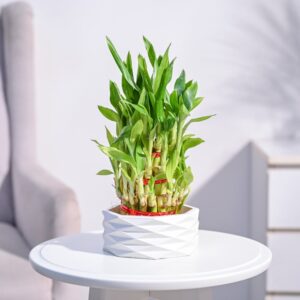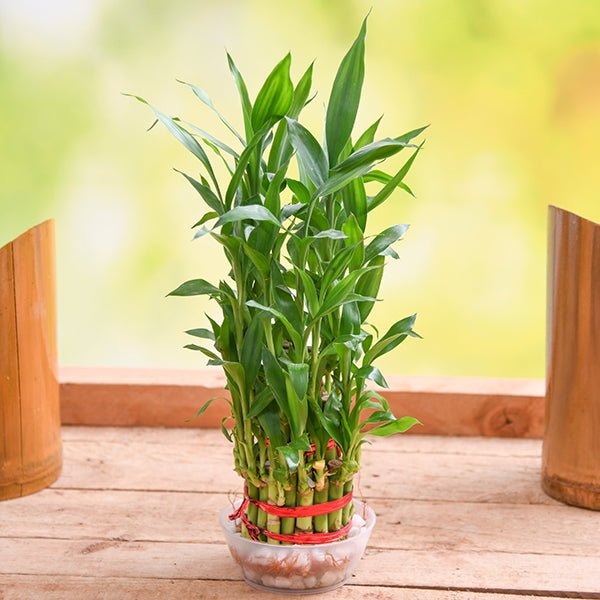how to care for lucky bamboo plant
Lucky bamboo (Dracaena sanderiana), known for its elegant, minimalist appearance and association with feng shui, is one of the most popular indoor plants worldwide. Despite its name, lucky bamboo isn’t true bamboo—it’s a tropical water plant that thrives in both soil and water. Whether you’re growing it for its aesthetic beauty or to bring luck and prosperity, this plant is low-maintenance and perfect for both beginners and experienced plant lovers.
In this detailed guide, we’ll explore how to care for lucky bamboo, including planting, light, watering, temperature, fertilization, propagation, and more. We’ll also address common problems and how to fix them. Let’s dive in!
| Common Name | Lucky bamboo, friendship bamboo, ribbon plant |
| Botanical Name | Dracaena sanderiana |
| Plant Type | Perennial shrub |
| Family | Asparagaceae |
| Mature Size | 1–5 ft. tall, 1–2 ft. wide (indoors) |
| Soil Type | Water or moist but well-drained soil |
| Sun Exposure | Partial shade |
| Bloom Time | Fall, winter (does not bloom indoors) |
| Flower Color | White |
| Native Area | Africa |

What is Lucky Bamboo?
Although often mistaken for real bamboo, lucky bamboo is a member of the Dracaena family, native to Central Africa. It is widely cultivated in Asia and is strongly associated with Chinese traditions, where it is believed to bring luck, health, and wealth. Lucky bamboo is often shaped into spirals, braids, and towers, making it a popular choice for gifts and home décor.
How to Grow Lucky Bamboo in Water
Growing lucky bamboo in water is a popular and traditional method. Here’s how to do it:
Materials Needed:
- A clean glass vase or container
- Pebbles or marbles
- Filtered or distilled water
- Healthy lucky bamboo stalks
Steps:
- Place a few inches of pebbles in the container for support.
- Insert the lucky bamboo stalks, making sure they are upright.
- Add filtered water until the roots are fully submerged.
- Change the water every 7–10 days to prevent bacterial growth.
- Rinse the vase and pebbles regularly to keep them clean.
Tip: Avoid tap water that contains chlorine or fluoride, as these can damage the plant.
Choosing the Right Lucky Bamboo PlantWhen selecting a lucky bamboo plant:
|

How to Grow Lucky Bamboo in Soil
Lucky bamboo is a popular indoor plant known for its elegant appearance and association with good fortune. While it’s commonly grown in water, lucky bamboo can also thrive in soil with the right care. Growing it in soil offers better root support and access to essential nutrients, promoting stronger and healthier growth over time. This method is ideal for those seeking a more traditional plant-care routine.
Watering
Watering lucky bamboo is simple but essential. Use distilled or filtered water to avoid chlorine and fluoride, which can harm the plant. Keep the roots submerged if grown in water, and change the water every 7–10 days. For soil-grown plants, keep the soil slightly moist but never soggy.
Soil
To grow lucky bamboo in soil, use a well-draining potting mix and a container with drainage holes. Plant the stalks upright and water regularly to keep the soil slightly moist, not soggy. Place the plant in bright, indirect light. Avoid overwatering and use distilled water for best results.
Light
Lucky bamboo thrives in bright, indirect sunlight. Avoid direct sun, as it can scorch the leaves. Place the plant near an east or north-facing window or under fluorescent lighting indoors. Insufficient light can slow growth and cause yellowing, so ensure it receives gentle, filtered light for best results.
Temperature and Humidity
Lucky bamboo thrives in warm, humid environments. Maintain a temperature range of 65°F to 90°F (18°C to 32°C) for optimal growth. Avoid cold drafts, air conditioners, and heaters. Increase humidity by misting the plant regularly or placing it near a humidity tray to keep the leaves healthy and vibrant.
Fertilizing
Fertilize your lucky bamboo plant sparingly using a diluted liquid houseplant fertilizer. Apply once every 6–8 weeks to promote healthy growth. Avoid over-fertilizing, as it can damage the roots and cause yellowing leaves. Always use fertilizer in clean water and never when the water hasn’t been changed recently.
pruning and shaping
To grow a healthy lucky bamboo plant, regular pruning and shaping are essential. Use clean, sharp scissors to trim overgrown shoots or yellowing leaves. Cut just above a node to encourage bushier growth. For shaping, train the stalks by rotating the plant toward the light or using wire frames. Pruning not only maintains the plant’s appearance but also stimulates new growth, keeping your lucky bamboo attractive and vibrant.
How to Propagate Lucky Bamboo Plant
Propagating lucky bamboo is simple and rewarding. Start by selecting a healthy, mature stalk and cut just below a node using sterilized scissors. Remove any lower leaves and place the cutting in a container of clean, distilled or filtered water. Keep it in bright, indirect sunlight. Within 2–4 weeks, roots will begin to grow. Once the roots are about 2 inches long, you can transfer the new plant to soil or continue growing it in water. Regularly change the water to prevent rot. This easy method allows you to multiply your lucky bamboo and share it with others.
Benefits of Lucky Bamboo
| Low Maintenance | Needs minimal attention to thrive. |
| Versatile Growing Options | Can grow in soil or water. |
| Aesthetic Appeal | Elegant and stylish, perfect for modern homes and offices. |
| Air Purifying | Helps improve indoor air quality. |
| Feng Shui Symbol | Brings positive energy and good fortune. |
Lucky Bamboo Common Problems and Solutions
Lucky bamboo is easy to grow in water or soil with bright, indirect light. Keep roots submerged in clean, filtered water or moist, well-draining soil. However, common problems can arise. Yellow leaves often result from overwatering or chlorine—switch to distilled water. Brown tips indicate dry air or fluoride—mist leaves and avoid tap water. Mushy stalks signal root rot—remove damaged stems and refresh water. Slow growth may be due to low light—relocate to a brighter spot. By maintaining proper light, clean water, and humidity, your lucky bamboo will thrive with minimal care and effort.
READ ALSO: https://growupplant.com/how-to-grow-and-care-for-swiss-cheese-plant/
Tips for Healthy Lucky Bamboo
|
Frequently Asked Questions (FAQs)
Can I grow lucky bamboo in the bathroom?
Yes! Bathrooms provide the humidity lucky bamboo loves, but make sure there’s indirect light.
Why is my lucky bamboo turning yellow?
It’s often caused by overwatering, poor water quality, or too much sunlight.
How tall does lucky bamboo grow?
Indoors, lucky bamboo can grow up to 3 feet tall under optimal conditions.
Can I keep lucky bamboo outdoors?
Lucky bamboo is sensitive to direct sun and cold temperatures. Outdoors is not recommended unless it’s shaded and warm year-round.
Conclusion
Caring for lucky bamboo is simple, rewarding, and spiritually enriching. Whether grown in water or soil, this versatile plant brings beauty and harmony to any space. By following the steps outlined in this guide—providing proper light, water, pruning, and placement—you’ll enjoy a healthy, vibrant lucky bamboo for years to come.
Whether you’re placing it in your office, home, or gifting it to someone, lucky bamboo is more than just a plant—it’s a symbol of positivity, growth, and good fortune.


